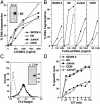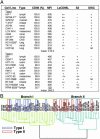Two CD95 tumor classes with different sensitivities to antitumor drugs
- PMID: 14504390
- PMCID: PMC208777
- DOI: 10.1073/pnas.2034995100
Two CD95 tumor classes with different sensitivities to antitumor drugs
Abstract
CD95 type I and II cells differ in their dependence on mitochondria to execute apoptosis, because antiapoptotic members of the Bcl-2 family render only type II cells resistant to death receptor-induced apoptosis. They can also be distinguished by a more efficient formation of the death-inducing signaling complex in type I cells. We have identified a soluble form of CD95 ligand (S2) that is cytotoxic to type II cells but does not kill type I cells. By testing 58 tumor cell lines of the National Cancer Institute's anticancer drug-screening panel for apoptosis sensitivity to S2 and performing death-inducing signaling complex analyses, we determined that half of the CD95-sensitive cells are type I and half are type II. Most of the type I cell lines fall into a distinct class of tumor cells expressing mesenchymal-like genes, whereas the type II cell lines preferentially express epithelium-like markers. This suggests that type I and II tumor cells represent different stages of carcinogenesis that resemble the epithelial-mesenchymal transition. We then screened the National Cancer Institute database of >42,000 compounds for reagents with patterns of growth inhibition that correlated with either type I or type II cell lines and found that actin-binding compounds selectively inhibited growth of type I cells, whereas tubulin-interacting compounds inhibited growth of type II cells. Our analysis reveals fundamental differences in programs of gene expression between type I and type II cells and could impact the way actin- and microtubule-disrupting antitumor agents are used in tumor therapy.
Figures



References
Publication types
MeSH terms
Substances
Grants and funding
LinkOut - more resources
Full Text Sources
Other Literature Sources
Research Materials

